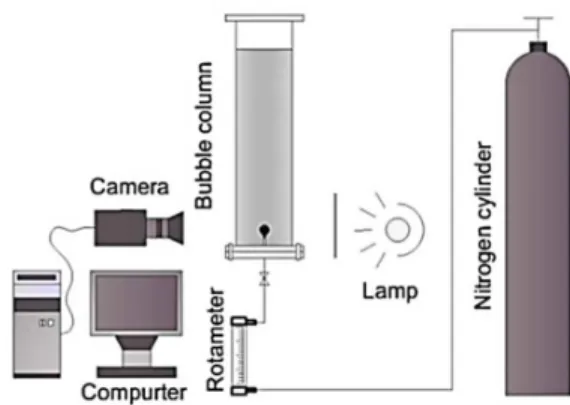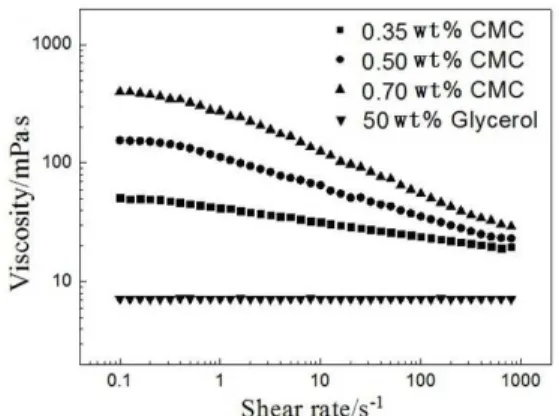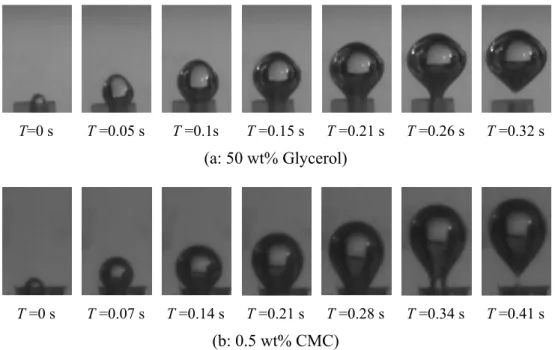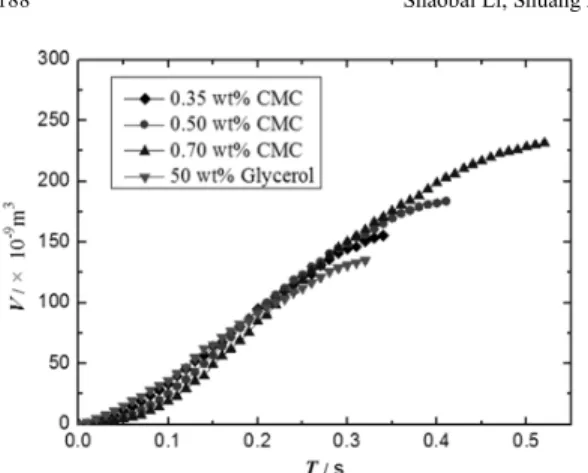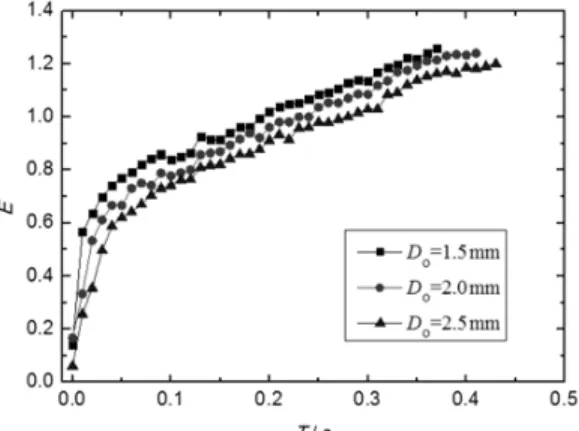ISSN 0104-6632 Printed in Brazil
www.abeq.org.br/bjche
Vol. 34, No. 01, pp. 183 - 191, January - March, 2017 dx.doi.org/10.1590/0104-6632.20170341s20150681
Brazilian Journal
of Chemical
Engineering
THE FORMATION BEHAVIOR OF A SINGLE
BUBBLE IN POWER-LAW FLUIDS
Shaobai Li, Shuang Xu, Zheng Yan, Rundong Li
*and Tianhua Yang
Liaoning Key Laboratory of Clean Energy and School of Energy and Environment, Shenyang Aerospace University, Shenyang, 110136, China.
E-mail: rdlee@163.com
(Submitted: October 26, 2015 ; Revised: December 24, 2015 ; Accepted: January 4, 2016)
Abstract - The formation behavior of a single bubble in power-law fluids (carboxymethyl cellulose solution, CMC) and Newtonian fluids (glycerol solution) was experimentally investigated via a high-speed camera. The effects of liquid property, orifice diameter and gas flow rate on bubble volume and aspect ratio were observed. It was found that the formation time and detaching volume increased with the increase of fluid viscosity. The increase of bubble aspect ratio during the bubble formation process was complex, with main emphasis on the decrease in the initial stage and an increase in the final stage along with the shear thinning property variation. Nevertheless, the bubble detaching volume, instantaneous volume and formation time increased following the increase of orifice diameter and gas flow rate. On the contrary, the bubble aspect ratio decreased with the orifice diameter increase but increased with a higher gas flow rate.
Keywords: Bubble formation; Power-law fluids; Rheological property; Bubble volume; Aspect ratio.
INTRODUCTION
The bubble motion in liquid phases is broadly en-countered in many industrial processes, such as chemi-cal, biochemichemi-cal, mineral and environmental pro-cesses (Chhabra, 2006; Li et al., 2012). In these pro-cesses, the formation behavior of bubbles has aroused wide concern due to its influence on bubble volume, velocity, gas holdup and residence time, which can further affect the mass transfer, heat transfer and chemical reactions between gas-liquid phases (Plesset et al., 2003). Thus, a profound understanding of the bubble formation process in liquid phases is essential for optimizing the design of gas-liquid equipment, and significant efforts have been devoted in the last few decades. The earliest studies on the formation of a single bubble can be found in the work of Bashforth et al. (1883). Afterwards, numerous experimental and numerical simulation studies on bubble formation have been undertaken. In the 1970s, Kumar et al. (1970) studied the mechanism of bubble formation
at a single orifice submerged in a gas–solid fluidized bed. Xie et al. (2012) experimentally investigated the formation and detachment of the bubbles generated from an immersed micro-orifice on a plate in a stag-nant and isothermal liquid. In addition to the experi-mental investigation, many researchers are dedicated to simulating the process of bubble formation by the direct numerical simulation (DNS) technique with prosperous computational methodology (Gerlach et al., 2007; Ma et al., 2012; Albdawi et al 2003; Wielhorski et al., 2014; Zahedi et al., 2014; Islam et al., 2015; Chakraborty et al. 2015).
These prior studies generally focused on Newto-nian fluids, whereas it should be recognized that most fluids encountered in many industrially important ap-plications (such as polymer, food, sewage sludge, slur-ries, and fermentation) display various non-Newtonian characteristics, including shear-thinning, shear-thick-ening, yield stress and viscoelastic characteristics (Chhabra et al., 2006). Despite their wide occurrence in diverse industrial applications, much less is known for bubble formation in non-Newtonian fluids due to their complicated rheological properties. Neverthe-less, few studies have reported on the formation mechanism of bubbles in non-Newtonian fluids in spite of these inherent difficulties. The evolution of single bubble detaching volume under various operat-ing conditions has been observed in early studies, with some simplified models for the bubble detaching vol-ume established (Acharya et al., 1978; Teraska et al., 1991; Miyahara et al., 1988). On the basis of a force balance analysis, Li et al. (2002) developed a novel theoretical model for the non-spherical bubble for-mation at an orifice submerged in a non-Newtonian fluid by introducing the effects of inline interactions between two consecutive bubbles. Fan et al. (2014) numerically investigated the bubble generation in non-Newtonian fluids using the CLSVOF method and evaluated the variation of bubble volume and aspect ratio.
The power-law fluid is a typical type of non-New-tonian fluid, the apparent viscosity variation of which could be described by a power-law model. Moreover, this non-Newtonian fluid has multiple applications. For example, it can play the role of thickener in the food industry, or be employed as polymer-flooding agent in order to enhance oil recovery. This study was undertaken to determine the influence of several note-worthy variables, including fluid rheological proper-ties, gas flow rate and orifice diameter, on the bubble formation in Newtonian and power-law fluids. By means of a high-speed digital camera, the instantane-ous volume, detaching volume and shape of the bub-ble were recorded along with the bubbub-ble formation
process in a single orifice. The results of this study are expected to extend the understanding of the factors af-fecting bubble formation and to be conducive to offer-ing some insight into optimization of related process.
EXPERIMENTAL
Apparatus
The studies of bubble formation in power-law flu-ids were carried out using the experimental set-up shown in Figure 1. The principal part of the bubble formation system was a rectangular bubble column with a size of 0.15 m×0.15 m×50 m. On this scale, the wall effect on bubble formation can be neglected ac-cording to our previous research (Li et al., 2012). Ni-trogen was injected via an orifice at the bottom of the bubble column from a gas cylinder by valve and rota-meter (within ±0.01 cm3/s). The orifices were made of 1 mm thick stainless steel. The inner diameters of the orifices used in the experiments were 1.0 mm, 1.6 mm and 2.4 mm, respectively. Three different gas-flow rates, 0.2 ml/s, 0.6 ml/s and 1.0 ml/s, were investi-gated. The bubble formation process was determined using a high-speed camera (Motion Pro Y5, RED-LAKE Global USA) with a lens (Nikon, 24-85 mm/ f2.8-4). In this work, the process of bubble formation was captured at a rate of 100 frames/s with the reso-lution of 500×1728 pixels. The selected sequence of frames was analyzed using Matlab 6.0 with a self-written code. All experiments were carried out at room temperature under constant pressure.
Figure 1: The experimental apparatus for bubble for-mation.
Materials
The Formation Behavior of a Single Bubble in Power-Law Fluids 185
(50 wt %) was used as the referenced Newtonian fluid. CMC aqueous solutions with different concentration (0.35 wt %, 0.5 wt % and 0.7 wt %) were used as the referenced power-law fluids. Densities of the liquids were measured using a density meter (AntonPaar, DMA5000, Austria) with an accuracy of ±1.0%. The rheological properties were determined using a pro-grammatic rheometer (Brookfield, DV-III, USA) with shear rate ranging from 0.1 to 1000 s-1. The results are
shown in Figure 2. From Figure 2, it can be observed that CMC solutions show shear thinning behavior. The variation of the apparent viscosity with shear rate could be described by the power-law model (Carreau et al., 1972):
1
n
K
(1)
where K is the consistency index and n presents the
flow index.
The physical properties of the experimental fluids are listed in Table 1.
Figure 2: Rheological characteristics of the liquids used.
Table 1: Rheological and physical properties of the experimental fluids.
Concentration (wt %)
K
(mPa·sn)
n σ
(mN·m-1) ρ
(kg·m-3) 0.35 wt % CMC 41.72 0.88 56.32 1002.63 0.50 wt % CMC 112.37 0.75 58.68 1004.82 0.70 wt % CMC 288.53 0.64 63.46 1009.31 50 wt %Glycerol 7.14 1 55.81 1131.24
THE FORCES ACTING ON A BUBBLE IN THE FORMATION PROCESS
The motion behavior of bubbles in the liquid phase is the result of the combination of diverse forces acting on the bubble, such as buoyancy, inertia force, surface tension, gravity force, the force from other bubbles, the forces from the liquid phase and
forces from solid interfaces. However, the influence of forces on the bubble volume, formation time and bubble shape are different. The theoretical description of those forces is stated as follows:
Buoyancy:
B l g l
F V g V g (2)
where, V is the volume of the bubble,
l and
g arethe density of the liquid phase and gas phase, respec-tively, and g is the gravitational acceleration. Adhesive force of the orifice:
o o
F D (3)
where, Do is the diameter of the bubble, and σ is the
surface tension of the liquids. The force of gas flow momentum:
2
M 2
O 4
g
Q F
D
(4)
where, Q is the gas flow rate. Bubble gravity:
3G b 11 96 l
F m g
g d (5)where, d is the diameter of the bubble. Drag force:
2 2
D D b
8
F C
d U (6)where
U
b is the velocity of the bubble centre, and CDis the drag coefficient of the bubble.
In low Reynolds number, the bubble drag coef-ficient could be expressed as CD16 / Re according to Hadamard-Ribczynky (1962) theory. For power-law fluids, the Reynolds number of the bubble is defined as:
2 2 n n
b b n b
U U d
Re
K U
K d
(7)
The force due to the wake of the former bubble:
2 2
1 1
2 4 D w
Fw d C (8)
where vw is the wake velocity of the previous detached
In accordance with Schlichting’s (1968) theory, the wake velocity profile of the leading bubble can be de-noted as follows:
1 2
1 1 exp
2 16
b D
w
U d C
x
(9)
where Ub1 is the velocity of the previous bubble, x is
the distance from the base of the previous bubble. r is the radial distance from the centre of the leading bub-ble base. CD1 is the drag coefficient of the previous
bubble. is the viscosity of the experimental fluids, which could be calculated by Eq. (1).
This bubble formation ends when the sum of de-taching forces is larger than or equal to that of the at-taching forces, which can be stated as:
O D G W M
B
F
F
F
F
F
F
(10)The above listed forces mainly influence the bub-ble formation time, thus impacting the bubbub-ble volume. In the case of bubble shape, an extra surface tension should be included apart from the above-listed influ-encing forces. The surface tension of the bubble can be described as:
2
F
dσ (11)RESULTS AND DISCUSSION
The Bubble Formation Process
Figure 3 shows the sequence of bubble formation in the Newtonian fluid (Figure 3a) and shear-thinning fluids (Figure 3b) with the conditions of Q=0.6 ml/s and Do=2.0 mm. The evolution is recorded at the
mo-ment when the gas–liquid interface just stands out on the orifice, and this is defined as the initial bubble growth point. It can be seen from Figure 3 that the main period of bubble formation could be divided into three remarkable stages: bubble nucleation, bubble growth and necking. Although the mechanisms of bubble evolution are similar regardless of Newtonian fluid or shear-thinning fluids, differences in bubble shape and volume during the stages are revealed. During the nucleation stage, the bubble emerges from the orifice in the form of a spherical segment, which transforms into part of a sphere while its periphery re-mains constant. As to the bubble growth stage, the bubble then expands greatly in length and radial di-rection, and the shape varies in different fluids. In the case of 50 wt% glycerol solution, bubble configura-tion remains part of a sphere-like shape while its base attaches to the orifice. However, the bubble becomes elongated in the 0.5 wt% CMC solution, and then ex-pands while moving upwards, followed by substantial
T=0 s T =0.05 s T =0.1s T =0.15 s T =0.21 s T =0.26 s T =0.32 s
(a: 50 wt% Glycerol)
T =0 s T =0.07 s T =0.14 s T=0.21 s T=0.28 s T=0.34 s T =0.41 s
(b: 0.5 wt% CMC)
The Formation Behavior of a Single Bubble in Power-Law Fluids 187
distortion of the bubble configuration in comparison with a spherical shape. In the final necking stage, ad-ditional gas is fed into the bubble, leading to the con-tinuous growth in bubble size. The bubble lifts away from the orifice, but is still attached to it through a neck, which also grows with time. When the sum of detaching forces is larger than or equal to that of the attaching forces, the neck is cut off and the bubble de-taches.
The differences in bubble shape evolution can be attributed to the different rheological properties of glycerol solution and CMC solutions. It can be ob-served from Figure 2 that CMC solutions show no-ticeable shear thinning behavior. Li et al. (1997) sim-ulated the passage of bubbles by exerting consecutive shear rates of glycerol solutions and CMC solutions in a rheometer. They found that, after the passage of a leading bubble, the memory effect of CMC solutions held the shear-thinning process for a certain period, which results in the decrease in local viscosity of the previous bubble wake. Nevertheless, this effect is not expected to occur in a Newtonian fluid. Therefore, the decrease in the viscosity of the previous bubble wake can influence the formation of following bubbles by two aspects. On the one hand, it increases the force due to the wake of the previous bubble (i.e.,
2 2 1
1
2 4
w D w
F d C ). Besides, it decreases the viscous
resistance right above the bubble. Accordingly, the bubble shape formed in CMC solutions is more elon-gated than that in Newtonian fluids.
The Influence of Liquid Rheological Properties
The bubble formation process in different fluids with Q=0.6 ml/s and DO=2.0 mm were conducted as
shown in Figure 4. It can be seen that, except for the formation time and detaching volume, the variation of bubble instantaneous volume displays a less pro-nounced change for different fluids during the for-mation process, although the variation curves of bub-ble volume with time slightly intersect. This trend is consistent with the report of Acharya et al (1978). The slight intersecting of variation curves could be ex-plained by the difference in surface tension of the tested fluids. As the bubble starts to generate, the gas flow must be against the liquid film of the orifice, the strength of which depends on the surface tension of the fluids. It can be found from Table 1 that the surface tension of 50 wt% glycerol is the lowest of the tested fluids, and the surface tension of CMC solutions in-creases with increasing CMC concentration, but the difference is quite slight due to the small surface ten-sion margin of the tested fluids. With the formation
process approaching to the end, the bubble attaching to the orifice goes through a narrow neck, leading to a slower growth in bubble size. It can be seen from Figure 4 that the formation time of a bubble in 50 wt% glycerol is shorter than that in CMC solution, in which the formation time of the bubble increases with the in-crease of the solution concentration. Hence, the vari-ation curves of bubble volume with time slightly in-tersect. Yet, it should also be noted that the distinc-tions in the bubble formation time and detaching volume in different fluids are apparent. For 50 wt% glycerol solution, the formation time is 0.32 s and the detaching volume is 135×10-9 m3. As to 0.35 wt% CMC solution, the formation time and the detaching volume are 0.34 s and 155×10-9 m3. When it comes to 0.50 wt% and 0.70 wt% CMC solution, the formation time and the detaching volume are 0.41 s and 183 ×10-9
m3, 0.52 s and 230×10-9 m3, separately. The bubble
formation time and detaching volume are related to the viscosity of the solutions. As demonstrated in Figure 2, the viscosity of 50 wt% glycerol is lower than those of CMC solutions, and the viscosity of CMC solutions increases with increasing solution concentration in the shear rate ranging from 0.1 to 1000 s-1. For a bubble rising in a liquid, the shear rate
(ie U/d) is less than 100 s-1(Li et al., 2012), thus for viscosity, 50 wt% glycerol<0.35 wt% CMC<0.50 wt% CMC<0.70 wt% CMC. Martín et al. (2006) ex-perimentally studied the influence of liquid viscosity on the bubble volume and formation time, and pro-posed that the velocity of the liquid layer of the gas-liquid interface must equal the velocity of the gas in its outer layer. As the viscosity increases, the velocity of the liquid layer is smaller, allowing the bubble to grow further until the bubble neck is cut. Additionally, an increase of the liquid viscosity is able to enhance the drag force (i.e. ) and reduce the force due to
the wake of the former bubble (i.e., ). Hence, the bubble volume and formation time increase along with the elevation of liquid viscosity.
The sequence of instantaneous states of bubble formation in Figure 3 could only roughly describe the evolution of bubble shape. Therefore, the aspect ratio is introduced as follows in order to more precisely describe the bubble shape evolution in the formation process.
a E
b
(12)
where b and a are the vertical diameter and horizontal diameter, respectively.
D
F
W
Figure 4: The variation of bubble volume with the liquid properties.
The influence of the liquid rheological properties on the variation of the bubble aspect ratio is presented in Figure 5. It is found that evolutions of the bubble shape in different liquids follow a similar tendency, by which the aspect ratios increase with prolonged time. For power-law fluids, the increase rate of the aspect ratio in the bubble nucleation stage declines as the concentration of the CMC solution increases, but shows an opposite trend along with the increase of the CMC solution concentration at the stage of bubble growth and necking. For 50 wt% glycerol solution, the aspect ratio initially increases rapidly with time, ar-riving at a maximum value (1.08) at 0.05 s. After-wards, it falls to about 1.04 at 0.16 s, and then reaches about 1.1 at the detaching period. In the study of Xie et al. (2012), it was found that a time interval indeed exists between the former bubble departure and the following bubble formation. The gas phase space pressure gradually increases caused by the persistent gas supplement. Once the gas–liquid interface of the orifice is broken through and the gas is pushed up, a new bubble formation process will get started. The vertical velocity of gas is greater because of the inertia effect, and the vertical velocity of gas would gradually disappear due to the existence of the liquid viscosity. Therefore, in the bubble nucleation stage, the increase of the aspect ratio in 50 wt% glycerol solution is fast-est owing to the lowfast-est viscosity, and the rate de-creases with the increase of CMC solution concentra-tion. As the process goes forward, the vertical velocity of the gas vanishes, due to the viscosity force and a buffer of bubble intracavity, and the viscosity force and the surface tension gradually become dominating. With respect to 50 wt% glycerol solution, the viscos-ity and surface tension are constant in all directions. Hence, the increase of the aspect ratio is so slow that the bubble shape is nearly spherical in the bubble growth stage. On the contrary, the increase of aspect
ratio of CMC solution exhibits a prompt trend with the concentration increasing at the stages of bubble growth. This distinction can be ascribed to the re-duced viscosity of the liquid above the bubble, which is caused by the shear-thinning effect from the trans-formation of CMC concentration.
Figure 5: The variation of bubble aspect ratio with the fluid properties.
The Influence of Orifice Diameter
The comparison of bubble volume in 0.5 wt% CMC solution (Q=0.6 ml/s) with three different ori-fice diameters is shown in Figure 6. The oriori-fice diam-eter shows a considerable effect on the bubble de-taching volume and instantaneous volume. The bub-ble detaching volume, instantaneous volume and for-mation time increase with enlargement of the orifice diameter. As known from section 3.1, the force of gas flow and adhesive force of the orifice are closely as-sociated with the orifice diameter. With increasing or-ifice diameter, the adhesive force of the oror-ifice in-creases, whereas the detaching force of the gas flow decreases. Eventually, the change in the force status of the bubble during the formation process affects the bubble formation time. Meanwhile, the bubble de-taching volume and instantaneous volume increase as well.
The Formation Behavior of a Single Bubble in Power-Law Fluids 189
increases. Meanwhile, the viscosity of the liquid on the top of the generated bubble is thinner than that of other area around the bubble. The result of the two impacts above gives rise to the bubble being more elongated with smaller orifice diameter.
Figure 6: The variation of bubble volume with the ori-fice diameter.
Figure 7: The variation of bubble aspect ratio with the orifice diameter.
The Influence of Gas Flow Rate
The bubble formation process for different gas flow rates with 0.5 wt% CMC solution and DO=2.0
mm was performed as demonstrated in Figure 8. The bubble volume profile shows that, when the gas flow rate increases, the instantaneous and detachment vol-ume of the bubble increase, but the bubble formation time significantly shortens. It should be noted that the density of gas phase can be considered to be constant in the process of bubble formation. Besides, the gas flow (FM) and the force of the former bubble wake
(FW) increase with the rising gas flow, resulting in
higher formation frequency and shorter formation time of the bubble. Nevertheless, both the instantane-ous and detached volumes increase due to the high gas
flow rate. The above results agree well with simulated results obtained by the VOF method (Fan et al., 2014).
Figure 8: Influence of gas flow rate upon the bubble volume.
Figure 9 depicts the influence of gas flow rate upon the bubble aspect ratio. In Figure 9, it is observed that the bubble aspect ratio increases with increasing the gas flow rate. One of the crucial reasons is that the force of gas flow momentum (FM in Eq. (4)) is
strength-ened along with the gas flow rate increase, which fur-ther promotes a bubble more stretched in the perpen-dicular direction. In addition, the former bubble wake (FW) also increases owing to the increasing bubble
generation frequency, which will result in the vis-cosity of the liquid above the forming bubble being thinner than that of other areas around the bubble.
Figure 9: Influence of gas flow rate upon the bubble aspect ratio.
CONCLUSIONS
diameters and gas flow rates were studied experimen-tally using a high-speed camera. The effects of the liquid property, gas flow rate and orifice diameter on volume variation and shape evolution were investi-gated respectively, from which the following conclu-sions were drawn.
(1)The bubble volume and formation time
in-crease with the inin-crease of fluid viscosity. The vis-cosity and rheological property play a notable role in bubble shape evolution. For 50 wt% glycerol solution, the increase of the aspect ratio is fastest owing to the low viscosity in the bubble nucleation stage, and then slowly declines, giving rise to the spherical bubble shape in the bubble growth stage. With regard to power-law fluids, the increase of the aspect ratio in the bubble nucleation stage decreases as the concentra-tion of CMC soluconcentra-tion increases at the bubble nuclea-tion stage, and then presents an increase in the stages of bubble growth and necking due to the shear-thin-ning effect of CMC concentration.
(2)The orifice diameter greatly influences the bub-ble detaching volume and instantaneous volume. The bubble detaching volume, instantaneous volume and formation time increase significantly with enlarge-ment of the orifice diameter. Besides, the bubble as-pect ratio decreases as the orifice diameter increases.
(3)Both the instantaneous and detachment volume of the bubble increase when the gas flow rate rises, but the bubble formation time shortens obviously. The bubble aspect ratio shows an increasing tendency as well.
ACKNOWLEDGEMENTS
The project support by the National Natural Sci-ence Foundation of China (Grant No. 21406141), the Scientific Research Starting Foundation for Doctors of Liaoning Province, China (Grant No. 20141078) and the Research Foundation of Education Bureau of Liaoning Province, China (Grant No. L2014060) are gratefully acknowledged.
NOMENCLATURE
a The horizontal diameter of bubble, (m)
b the vertical diameter of bubble, (m) CD drag coefficient, dimensionless
d diameter of bubble, (m)
Do diameter of orifice, (m)
E bubble aspect ratio
D
F drag force, (N)
G
F bubble gravity, (N)
M
F the force of gas flow momentum, (N)
F adhesive force of orifice, (N)
w
F The force of the wake of the former bubble,
(N)
g gravity acceleration, (m·s-2)
K consistency coefficient
b
m bubble mass
n flow index, (dimensionless)
Q gas flow rate, (m3·s-1)
the radial distance from the center of the previous bubble base, (m)
Re Reynolds number
T Time, (s)
b
U the velocity of the bubble center, (m·s-1)
bl
U the velocity of the previous bubble, (m·s-1)
V bubble volume, (m3)
vw the wake velocity of the previous bubble,
(m·s-1)
x the distance from the base of the previous bubble, (m)
Greek Symbols
shear rate, (s-1)
μ viscosity of liquid, (mPa·s)
g
gas density, (kg·m-3)
1
liquid density, (kg·m-3)
σ surface tension, (mN·m-1)
REFERENCES
Acharya, A., Mashelkar, R. A., Ulbrecht, J. J., Bubble formation in non-Newtonian liquids. Industrial & Engineering Chemistry Fundamentals, 17, p. 230-232 (1978).
Albadawi, A., Donoghue, D. B., Robinson, A. J., Robinson, A. J., Murray, D. B., Delaure, Y. M. C., On the analysis of bubble growth and detachment at low capillary and bond numbers using volume of fluid and level set methods. Chemical Engineer-ing Science, 90, p. 77-91 (2013).
Bashforth, F., Adams, J. C., An Attempt to Test the Theories of Capillary Action. Cambrige University Press, Cambridge (1883).
Carreau, Pierre, J., Rheological equations from mo-lecular network theories. Journal of Rheology, 16, p. 99-127 (1972).
The Formation Behavior of a Single Bubble in Power-Law Fluids 191
quiescent high-density liquid. AIChE Journal, 61(11), p. 3996-4012 (2015).
Chhabra, R. P., Bubbles, Drops, and Particles in Non-Newtonian Fluids. CRC Press (2006).
Davidson, J. F., Schuler, B. O. G., Bubble formation at an orifice in an inviscid liquid. Transactions of the Institution of Chemical Engineers, 38, p. 335-342 (1960).
Fan, W., Sun, Y., Chen, H., Bubble volume and aspect ratio generated in non-Newtonian fluids. Chemical Engineering & Technology, 37, p. 1566-1574 (2014).
Gerlach, D., Alleborn, N., Buwa, V., Durst, F., Nu-merical simulation of periodic bubble formation at a submerged orifice with constant gas flow rate. Chemical Engineering Science, 62, p. 2109-2125 (2007).
Gnyloskurenko, S. V., Byakova, A. V., Raychenko, O. I., Nakamura, T., Influence of wetting conditions on bubble formation at orifice in an inviscid liquid. Transformation of bubble shape and size. Colloids and Surfaces, A: Physicochemical and Engineer-ing Aspects, 218, p. 73-87 (2003).
Islam, T., Ganesan, P., Sahu, J. N., Hamad, F. A., Nu-merical study to investigate the effect of inlet gas velocity and Reynolds number on bubble for-mation in a viscous liquid. Thermal Science, 19(6), p. 15-15 (2015).
Kulkarni, A. A., Joshi, J. B., Bubble formation and bubble rise velocity in gas-liquid systems: A re-view. Industrial & Engineering Chemistry Re-search, 44, p. 5873-5931(2005).
Kumar, R., Kuloor, N. R., The Formation of Bubbles and Drops. Adv. Chem. Eng., Academic Press, New York (1970).
Levich, V. G., Physicochemical Hydrodynamics. Prentice-Hall, Englewood Cliffs, NJ (1962). Li, H. Z., Mouline, Y., Choplin, L., Funfschillinga, D.,
Marchala, P., Midouxa, N., Rheological simulation of in-line bubble interactions. AIChE Journal, 43, p. 265-267 (1997).
Li, H. Z., Mouline, Y., Midoux, N., Modelling the bubble formation dynamics in non-Newtonian flu-ids. Chemical Engineering Science, 57, p. 339-346 (2002).
Li, S., Ma, Y., Fu, T., Zhu, C., Li, H., The viscosity distribution around a rising bubble in shear-thin-ning non-Newtonian fluids. Brazilian Journal of Chemical Engineering, 29(2), p. 265-274 (2012). Li, S., Ma, Y., Jiang, S., Fu, T., The drag coefficient
and the shape for a single bubble rising in non-Newtonian fluids. Journal of Fluids Engineering,
134, p. 669-679 (2012).
Ma, D., Liu, M., Zu, Y., Tang, C., Two-dimensional volume of fluid simulation studies on single bub-ble formation and dynamics in bubbub-ble columns. Chemical Engineering Science, 72, p. 61-77 (2012).
Martin, M., Montes, F. J., Galan, M. A., On the influ-ence of the liquid physical properties on bubble volumes and generation times. Chemical Engi-neering Science, 61, p. 5196-5203 (2006). Miyahara, T., Wang, W. E. I. H., Takahashi, T., Bubble
formation at a submerged orifice in non-Newto-nian and highly viscous Newtonon-Newto-nian liquids. Jour-nal of Chemical Engineering of Japan, 21, p. 620-626 (1988).
Pamperin, O., Rath, H., Influence of buoyancy on bubble formation at submerged orifices. Chemical Engineering Science, 50, p. 3009-3024 (1995). Plesset, M. S., Prosperetti, A., Bubble Dynamics and
Cavitation. Annual Review of Fluid Mechanics, 9 p. 145-185 (2003).
Schlichting, H., Boundary Layer Theory. 6th Edn. McGraw-Hill, N.Y. (1968).
Terasaka, K., Tsuge, H., Bubble formation at a single orifice in non-Newtonian liquids. Chemical Engi-neering Science, 46, p. 85-93 (1991).
Tsuge, H., Hydrodynamics of Bubble Formation from Submerged Orifices. In: Encyclopaedia of Fluid Mechanics, Gulf Publishing Company: New York, Vol. 3, 191 (1986).
Vakhshouri, K., Grace, J. R., Modeling of bubble for-mation at a submerged orifice in a gas-fluidized bed. Chemical Engineering Research & Design, 87, p. 843-851 (2009).
Wielhorski, Y., Abdelwahed, A., Arquis, E., Numeri-cal simulation of bubble formation and transport in cross-flowing streams. The Journal of Computa-tional Multiphase Flows, 6, p. 299-312 (2014). Xie, J., Zhu, X., Liao, Q., Wang, H., Ding, Y. D.,
Dy-namics of bubble formation and detachment from an immersed micro-orifice on a plate. International Journal of Heat & Mass Transfer, 55, p. 3205-3213 (2012).
Zahedi, P., Saleh, R., Moreno-Atanasio, R., Yousefi, K., Influence of fluid properties on bubble for-mation, detachment, rising and collapse; Investiga-tion using volume of fluid method. Korean Journal of Chemical Engineering, 31(8), p. 1349-1361 (2014).
